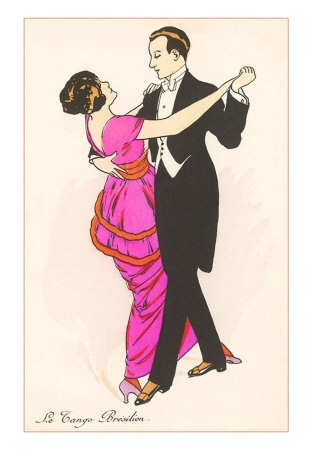The dance floor has always been an alternate reality. For as long as women and men have danced together, the dance space was a place where the regular rules of society were partially suspended, and a different set of rules were applied; rules that were optimized to bring men and women together, often within a society that offered few other approved alternatives.

This is as true today as it was in the past. If I were to go to a party in our present era, and embrace every woman there for around three minutes each, it would be very awkward. There would be consequences. However, if you add a bit of music and start dancing, then suddenly society approves and it’s a good thing.
And this good thing is a degree of physical intimacy and connection that is not available in any other social situation, and is traditionally not limited to just a single partner. It is an opportunity for men and women to make substantive, though brief contact which was, for at least the last millenium or so, a key tool for facilitating courtship; allowing girls and boys, women and men to sample each other’s company, and perhaps even have a private conversation that would not be overheard.
While dance participation declined after marriage, many married people continued to dance. The dance floor world remained available to the married and otherwise committed, but encouraged them to mix it up with partners other than their significant other. It was and is a socially sanctioned brief respite from strict monogamy.
In society, husbands and wives consider a ball or dance, or, indeed, any form of entertainment, the occasion for seeing their old friends and acquaintances and making new ones, not for staying together. At dinners they are separated as far as possible, to give them both a chance to express themselves as individuals, not as halves of a never-to-be-divided whole. At dances, though a couple who happen to like dancing together may, and do often, take a turn, the etiquette of the evening is that they should both have too many partners to be able to see much of each other. If they are seen constantly together, the idea conveyed to onlookers is that they don't know many people and are not having a much gayer time than they would have together at home. This may be far from the case, but the impression is conveyed all the same. Married men and women go out to see people, not to be with each other. - Washington Post 1926
Jealousy regarding your life partner's dance partners was regarded as boorish and tiresome. These days, however I frequently encounter people who, while they are dancing the dances of the age of promiscuous partner sharing, refuse to let their partners dance with anyone else. Such an attitude, back in the day, would have occasioned uncomplementary remarks, and today does a serious disservice to those (predominately women) who do not have a dedicated partner.
In some eras, such as early 19th Century Britain, in fashionable circles it was actually forbidden for husbands and wives to dance together.
If you accompany your wife to a dance, be careful not to dance with her. Such are some of the canons of the ball.
“The Laws of Etiquette; Or, Short Rules and Reflections for Conduct in Society” - 1836
There was a very interesting and telling social convention in the 19th Century ballroom: a woman could not accept a dance invitation from a man to whom she had not been introduced, so it was incumbent on the host and hostess to bustle about making introductions.
In normal social intercourse, an introduction was an introduction. Barring some unforgivable social transgression by one of the parties, an introduction was lasting and binding and you were expected to “know” the person when next you met. However, if a man and woman had been introduced at a dance, it was up to the woman to decide if it was binding: to decide if she wanted to allow connections made in the dance floor world to make their way into the “real” world.
It marked the ballroom as a safe place for experimenting with multiple social connections, and gave a woman the power, unavailable elsewhere, to wipe the slate clean of those which she didn’t want to continue, while embracing those she did.
While the dance floor is still a world where different rules apply, it is, in our current Dark Ages of social dance, a world inhabited by a very few people, only a tiny fraction of the numbers who regularly inhabited it a few decades ago. Many kids still dance (though far fewer than in the past), but their dances are generally solo gyrations to deafening music - and they stop dancing as they move into adulthood. The intimacy and quiet connection of the past has been lost to them and to the adults who, with a few exceptions, have no connection to dancing other than watching it on TV.
It's a sad loss.
